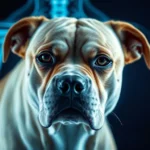
Introduction
When it comes to the health of our beloved pets, understanding common conditions is essential. One such condition is umbilical hernias in dogs. An umbilical hernia occurs when tissue protrudes through an opening in the abdominal muscles near the belly button (umbilicus). This type of hernia is distinct from other hernias, such as inguinal and diaphragmatic hernias, which occur in different anatomical locations.
This topic is particularly relevant for dog owners as umbilical hernias are relatively common, especially in certain breeds. Statistics indicate that small breeds and certain purebreds, such as Yorkshire Terriers and Chihuahuas, are more prone to this condition. Awareness of umbilical hernias in dogs can help pet owners recognize the symptoms, seek timely veterinary care, and understand treatment options.
Understanding Umbilical Hernias
What is an Umbilical Hernia?
An umbilical hernia in dogs is defined as a defect in the abdominal wall where abdominal contents, such as fat or intestines, protrude through the umbilical ring. This occurs when the muscles around the umbilical area don’t close properly after birth. In many cases, these hernias can appear as a soft swelling under the skin near the belly button.
Causes of Umbilical Hernias
Several factors contribute to the development of umbilical hernias in dogs:
- Genetic Factors: Certain breeds are genetically predisposed to developing hernias. This is particularly true for small and toy breeds.
- Developmental Issues: During puppyhood, if the abdominal wall does not close completely, it can lead to a hernia.
- Trauma or Injury: Physical trauma can also result in an umbilical hernia, although this is less common.
Symptoms and Signs
Dog owners should be vigilant for signs of an umbilical hernia. Common symptoms include:
- Physical Characteristics: A noticeable bulge or swelling under the skin near the belly button is the primary indicator. This may become more prominent when the dog is active or straining.
- Behavioral Signs: Dogs with hernias may show signs of discomfort, such as whining, reluctance to play, or changes in appetite and activity level.
- When to Seek Veterinary Assistance: If you notice a bulge that seems painful or swollen, or if your dog exhibits signs of distress, it’s crucial to consult a veterinarian promptly.
Diagnosis of Umbilical Hernias
Veterinary Examination
If you suspect your dog has an umbilical hernia, a veterinary examination is the first step. Expect the vet to perform a thorough physical exam, palpating the area to assess the size and nature of the bulge.
- Common Diagnostic Tests: In some cases, your vet may recommend additional diagnostic tests such as ultrasound or X-rays to assess the contents of the hernia and check for any complications.
Differentiating from Other Conditions
Distinguishing umbilical hernias from other types of hernias is essential for proper treatment. Here are some key points to consider:
- Inguinal Hernias: Occur in the groin area and may also present with a bulge, but the location is different.
- Strangulation: A serious complication where blood supply to the herniated tissue is compromised. Signs include severe pain, vomiting, and lethargy, necessitating immediate veterinary care.
Treatment Options
Surgical Intervention
The most common and effective treatment for umbilical hernias is surgical repair. The procedure involves:
- Overview of Surgical Procedures: During surgery, the vet will push the protruding tissue back into place and repair the abdominal wall.
- Risks and Benefits of Surgery: While surgery is generally safe, there are risks associated with anesthesia and complications during recovery. However, the benefits typically outweigh these risks, especially if the hernia is causing discomfort or has the potential for strangulation.
Non-Surgical Management
In some cases, particularly if the hernia is small and not causing any symptoms, surgical intervention may not be immediately necessary.
- Monitoring and Care Tips: If surgery is not indicated, keep an eye on the hernia and monitor for any changes. Regular vet check-ups are essential to ensure that the condition does not worsen.
Post-Surgery Care
Post-operative care is crucial for a smooth recovery. Here’s what to expect:
- Recovery Process and Timelines: Most dogs will recover from umbilical hernia surgery within a few weeks. Your vet will provide specific aftercare instructions.
- Signs to Watch For After Surgery: Look for signs of infection (redness, swelling, discharge), persistent pain, or unusual behavior. If any of these occur, contact your vet immediately.
Prevention Strategies
Breeding Considerations
Responsibility in breeding practices can significantly reduce the incidence of umbilical hernias.
- Importance of Responsible Breeding Practices: Breeders should screen for genetic predispositions and avoid breeding dogs that have a history of hernias.
- Genetic Screening: Testing for inherited conditions can help identify at-risk breeds and individuals.
Health Monitoring in Puppies
Regular health checks are vital for early detection of potential issues.
- Regular Vet Check-Ups: Puppies should have routine veterinary visits to monitor their growth and development. Early intervention can catch hernias before they become problematic.
- Importance of Early Intervention: Addressing small hernias early may prevent complications later on.
Lifestyle Adjustments
Making simple lifestyle changes can help maintain your dog’s overall health and reduce the risk of hernias.
- Safe Play and Exercise Recommendations: Encourage safe play and limit activities that may put excessive strain on the abdomen during puppyhood.
- Nutritional Considerations: Provide a balanced diet to support healthy growth and development, which can help reduce the risk of developmental issues that lead to hernias.
FAQs about Umbilical Hernias in Dogs
Common Questions
-
What breeds are most susceptible to umbilical hernias?
Small breeds such as Yorkshire Terriers, Chihuahuas, and Pomeranians are more commonly affected. -
Can umbilical hernias heal on their own?
While some very small hernias may close on their own, most will require surgical intervention to prevent complications. -
Are there any long-term effects of umbilical hernias?
If untreated, umbilical hernias can lead to serious complications, including strangulation and infection. Timely treatment often leads to a full recovery without long-term effects.
Expert Answers
Veterinarians emphasize the importance of recognizing the signs of umbilical hernias early. Regular veterinary visits and monitoring your pet’s condition can help in managing this issue effectively.
Conclusion
In summary, understanding umbilical hernias in dogs is crucial for pet owners. Recognizing the symptoms, knowing the diagnosis process, and being aware of treatment options can significantly impact your dog’s health. Regular veterinary visits and responsible breeding practices can help prevent this condition from affecting your furry friends.
Awareness is the first step toward proactive health management. Engaging with your veterinarian about any concerns can ensure a healthy, happy life for your dog.









